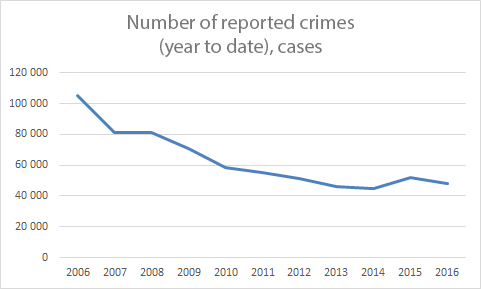Tatarstan during 10 years: how republic still copes with two economic crises
The budget grew 3 times, population’s receipts – 4 times, the number of reported crimes reduced more than twice
An agreement between the Russian Federation and Tatarstan expires on 26 June 2017. Now negotiations on prolongation of the document are actively taking place. This is why Realnoe Vremya's analytic staff decided to study the statistics during the last 10 years. An expected perceptible growth was noticed in the republic in the majority of indicators, but in some cases, it is just nominal while Tatarstan still copes with the 2008 and 2014 crises in certain sectors.
Budget: a threefold growth and return to surplus
According to the statistics, the biggest budget for Tatarstan during 10 years in both expenditures and receipts was in 2016. In 2016, receipts of the executed consolidated budget made up 261,98 billion rubles, expenditures — 261,51bn rubles, which is 472 million rubles less. In comparison with 2015, budget receipts increased by about 20 billion rubles while expenditures – 13 billion rubles only.
Generally speaking, it is curious that 2016 was the first year during six years when receipts exceeded expenditures. That has not happened since 2010. When receipts were 240,9 billion rubles, expenditures totalled just 193,9 billion rubles. Earlier in 2009, 2008 and 2006, budget receipts were always higher than expenditures. Only 2007 was an exception. From 2011 to 2015, expenditures also passed receipts. At the same time, total budget volumes were considerably lower 10 years ago. For instance, in 2006, expenditures amounted to 88,3 billion rubles while expenditures – 86 billion rubles. It is only 1/3 of the 2016 budget.
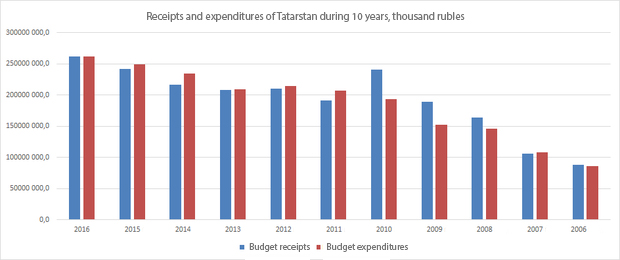
It is curious to note that if budget expenditure and receipt ratio is remarkable in 2007, an unexpected growth of GRP was in 2009. Earlier Tatarstan's GRP stably grew since at least 2006. It continued to do it since 2010 too. However, in 2009, it suddenly dropped (it was 926 billion rubles in 2008 and just 885 billion in 2009). In general, Tatarstan's GRP increased more than three times during 10 years – from 605,9 billion rubles to 1,9 trillion rubles.
A similar situation with fixed capital investments was in 2009 – it is the only year when they reduced in comparison with the previous year. In 2008, they were equal to 268,6 billion rubles and just 268 billion rubles in 2009. This indicator per capita did not decrease, but the growth was small compared to results of any other city during the decade – from 70,900 to 71,200 rubles per citizen.
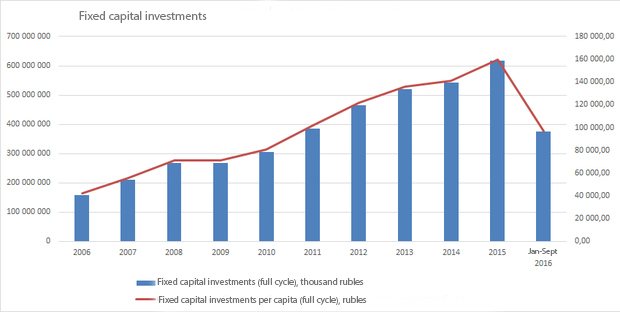
Record decline in unemployment and fourfold growth of receipts
The misfortunes in 2009 can be probably linked with the crisis in 2008 – its consequences became seen next year. The ''failure'' in 2009 characterises the results of the unemployment level that was officially registered in early 2010 better. Then the crises perhaps affected the labour market. In comparison with the economically active population, the indicator was 2,8% though it was just 1,33%. Interestingly, it constantly reduced until 2015 having reached 0,74% and then grew a bit at the beginning of 2016 to 0,8%. It fell again to 0,71% by 1 January 2017 having reached the absolute minimum during 10 years.
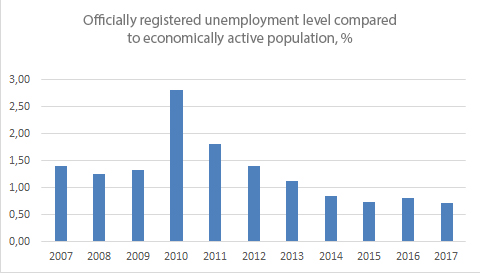
But the 2008 crisis almost affected receipts per capita: this indicator grew year after year having risen from 9,185 rubles to 33,160 rubles during 10 years. Growth paces reduced a bit only in 2009. However, we should not overestimate the almost fourfold growth of receipts per capita: unfortunately, inflation also changed during the last 10 years. New housing supply also grows along with it. In general, there have been 1,5 times more dwellings in a year during 10 years. The 2006 indicator was equal to 1,78 million square metres, it grew to 2,4 million square metres by 2016. This result fell only in 2010 after a record in 2008 (at that moment). Particularly a considerable growth of new housing supply in the countryside is noticeable here – almost twice, from 385 to 785,000 square metres. Meanwhile, the volume of dwellings built by private developers has almost changed for 10 years. What is more, it even reduced from 1,045 to 1,037 million square metres (though the result in 2015 was better — 1,182 million square metres).
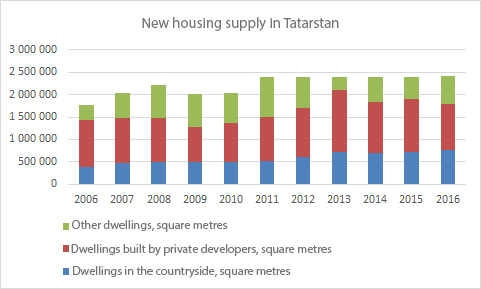
Population grew by 3% only
As for non-economic but social indicators, here the situation in Tatarstan is more stable than in the economy. For instance, the number of population stably grew during 10 years: an exception was in 2007 when at the beginning of the year the number was almost 1,000 people less than in early 2006. At the same time, the final result is unlikely to considered as impressing: in the end, the number of permanent population increased from 3,76 to 3,886 million people during 10 years. It increased by 11,300 people in a year on average. But the result was ensured by 2012 to a great degree. The number of population grown by 13-18,000 people in a year since then. Earlier, the annual gain was no more than 10,000 people.
As for net migration rate (the difference between immigrants and emigrants), 2009 was the most successful year for Tatarstan: then the indicator totalled about 11,000 people. Similar results were from 2006 to 2008 – from 9 to 10,500 people. The indicator sharply changed from 2010 – to 4,700 people. In the next years, migration rate did not pass 7,000 people (in 2014). It reached the least result in 2015 – 3,500 people. The result from January to November 2016 amounted to 5,800 people.
It is difficult to follow the tendencies if we consider migration rate separately by immigrants and emigrants. The greatest number of people from both categories during 10 years was in 2014. About 107,000 people came to Tatarstan then, and less than 100,000 left the republic. This result can be indirectly linked with the events in Donetsk and Lugansk Oblasts of Ukraine when many people from these regions came to Russia. It should be reminded Realnoe Vremya already wrote that the flow of Ukrainians to Tatarstan suddenly rose in 2014. In 2012, 382 citizens of Ukraine arrived in the region, 370 people came in 2013, and the number suddenly grew to 1,149 in 2014. In 2015, Tatarstan officially hosted 1,291 people. 975 citizens of Ukraine came to Tatarstan in 2016 while 324 people left the region.
In general, the reduction in both indicators lasted until 2009. Then there was a sudden growth in 2012. When the new crisis appeared after 2014, the number of immigrants and emigrants started to fall.
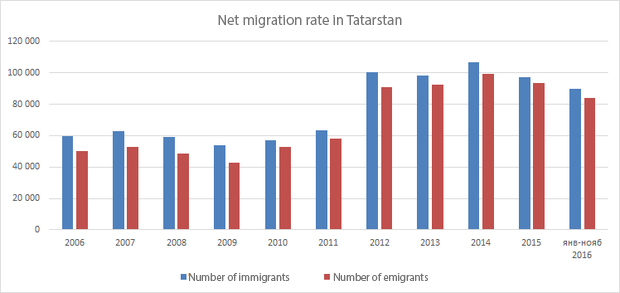
There is nobody to work, but higher pensions are needed
Speaking of the population pattern, the number of people who are older than working population has considerably increased in the last 10 years (from about 20% to 24%). On the contrary, the number of employable people reduced even more – from about 63% to 58%. A gradual reduction of employable people was noticeable from 1 January 2008: a result of 63,13% was fixed then, it has been reducing since then. The number of people who are older than working population started to increase earlier – at least since 2006.
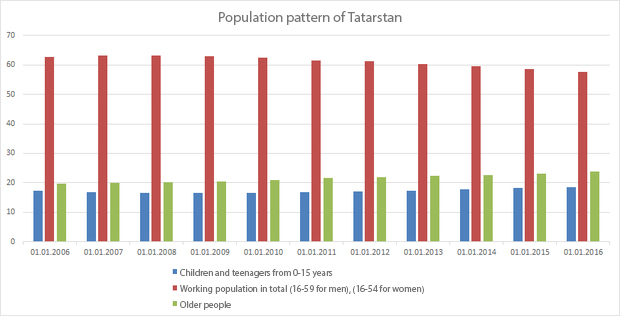
As for the number of children and teenagers under 15, this indicator grew but a bit. In 2006, it was 17,41%. It gradually shrank to 16,47% by 2009. It had been gradually growing since then and was 18,6% by 1 January 2016.
In addition, the lifespan of Tatarstan residents stably increases except some years. The lifespan of men increased almost by 5 years during 10 years on average, from 62,7 to 67 years. The lifespan of women is 3 years shorter. However, in the end, the lifespan of women is still longer – almost 78 years.
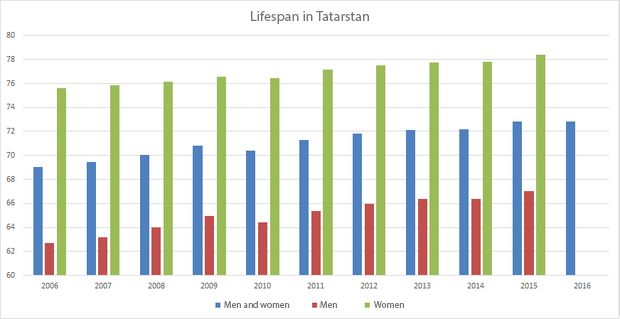
According to the statistics, safety dynamics is positive. The annual number of reported crimes reduced more than twice during 10 years – from 105 to 48,000. At the same time, the least number of crimes was registered in 2014 – 44,781 crimes. In 2015, it grew to 52,000. It fell again to 48,150 in 2016.
